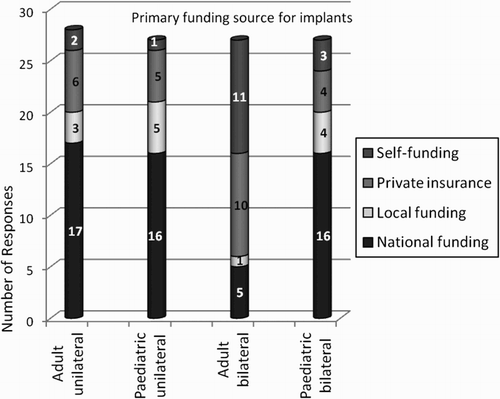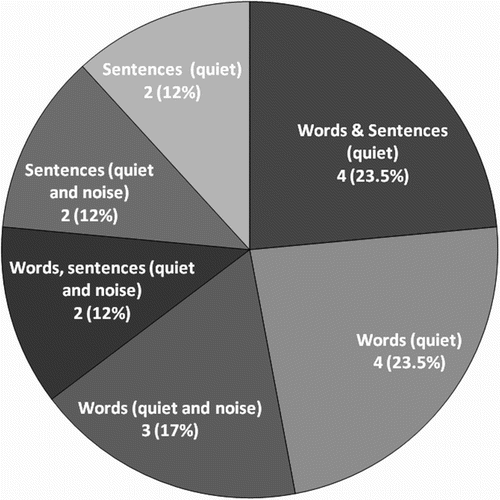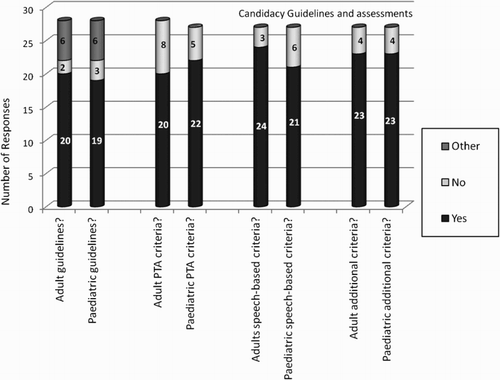Abstract
Background: The goal of this work was to determine international differences in candidacy based on audiometric and speech perception measures, and to evaluate the information in light of the funding structure and access to implants within different countries.
Method: An online questionnaire was circulated to professionals in 25 countries. There were 28 respondents, representing the candidacy practice in 17 countries.
Results: Results showed differences in the funding model between countries. Unilateral implants for both adults and children and bilateral implants for children were covered by national funding in approximately 60% of countries (30% used medical insurance, and 10% self-funding). Fewer countries provided bilateral implants routinely for adults: national funding was available in only 22% (37% used medical insurance and 41% self-funding). Main evolving candidacy areas are asymmetric losses, auditory neuropathy spectrum disorders and electro-acoustic stimulation. For countries using speech-based adult candidacy assessments, the majority (40%) used word tests, 24% used sentence tests, and 36% used a mixture of both. For countries using audiometry for candidacy (70–80% of countries), the majority used levels of 75–85 dB HL at frequencies above 1 kHz. The United Kingdom and Belgium had the most conservative audiometric criteria, and countries such as Australia, Germany, and Italy were the most lenient. Countries with a purely self-funding model had greater flexibility in candidacy requirements.
Introduction
The criteria for cochlear implant (CI) candidacy in both children and adults are known to have considerable variation between countries and also between some regions within countries. Recent UK research (CitationLovett et al., 2015; CitationVickers et al., 2015) looking at candidacy for bilateral implants in children suggests that the current audiometric candidacy criteria (equal to or greater than 90 dB HL at 2 and 4 kHz) may be too strict. Based on this research, it may be more appropriate to relax the criteria to be greater than or equal to 80 dB HL at 2 and 4 kHz. In countries such as Australia and Germany, there is a much more relaxed audiometric cut-off level that allows all potential candidates to be identified audiometrically. Subsequently, clinical observation and assessment of likely outcome are used to determine if individual candidates are making appropriate progress with their hearing aids, and whether they would be likely to gain more benefit with implants. CitationLeigh et al. (2011) recommended that the audiometric criteria for Australia should be set at 70 dB HL four-frequency average (0.5, 1, 2, and 4 kHz) based on outcome comparisons with hearing aid users.
With technological improvements in implants in recent years, and changes in surgical techniques that have improved the preservation of residual hearing, implant outcomes have improved (CitationBlamey et al., 2013). All the CIs that are available today are able to provide additional acoustic amplification for any preserved natural hearing, together with the electrical delivery of sound through the implant itself, making implants a viable intervention for individuals with low-frequency residual hearing.
There is considerable variation at an international level, not only in the criteria for implantation, but also in access to CIs, including access to funding, both for adults and children (CitationDe Raeve and Wouters, 2013; CitationLiang and Mason, 2013; CitationOliver, 2013; CitationRaine, 2013; CitationSorkin, 2013), and this could be affected by the model of service delivery and funding as well as cultural and language aspects.
The goal of this article was to evaluate the differences in CI candidacy for both adults and children across different regions of the world, in the context of the variation in approaches to funding and models of service delivery found in individual territories.
Method
A questionnaire was developed to gather information on the following four topics:
Methods of funding for unilateral and bilateral implants;
The presence or absence of specific guidelines, or criteria, to which teams are obliged to comply. The categories were based on evaluations and aetiological factors, for example: pure tone audiometry (PTA); speech perception tests (in quiet or in noise); duration of deafness; onset of deafness; age of the candidate; aetiology of deafness; presence of other disabilities; any other relevant factors;
Specific factors that can exclude implantation;
Whether there is flexibility within the system that might allow a centre to implant someone falling outside the programme's standard criteria.
The questionnaire went through two stages of validity review prior to circulation. Initially the members of the British Cochlear Implant Group (BCIG) working group on candidacy reviewed the first version of the questionnaire to ensure that the questions appropriately addressed the associated topic headings and could be analysed effectively to answer the research questions. The second stage was to send the questionnaire to a group of five experienced clinicians to determine if the questionnaire was clear and easy to complete.
The questionnaire was modified following the validation stages and then implemented as an online questionnaire in the University College London (UCL) OPINIO software. The link was sent out initially to 75 professionals working in CI clinics in 25 countries, and then further distributed to the member states of Euro-CIU the European CI Users association, for distribution to clinicians within their countries.
The questionnaire was open for completion for one calendar month.
Results
In total, 28 respondents completed the questionnaire, representing 17 countries: Argentina, Australia, Belgium, Bosnia Herzegovina, Brazil, Finland, Germany, India, Italy, The Netherlands, New Zealand, South Africa, Spain, Switzerland, Portugal, United Kingdom, and The United States of America. One centre was purely adult and another purely paediatric so they were unable to answer all of the questions relating to adult or paediatric guidelines. The results will be reported according to the four main subject areas.
Funding for unilateral and bilateral implants
Fig. shows the primary source of funding for unilateral and bilateral CIs for adults and children. All territories had a mixed model of funding but this figure shows the main route for funding for the majority of implantations in the country.
Figure 1 A stacked bar chart indicating the main source of funding for implants in a specific region, separated according to adult and paediatrics and also unilateral and bilateral implants. Each shaded section relates to the number of respondents that reported a specific outcome and the numbers indicate the exact number of respondents giving that response.

A similar pattern is observed for adult and paediatric unilateral and paediatric bilateral implantation, the breakdown of the specific numbers by category are shown in Fig. . The results show that for approximately 60% of territories the funding was provided nationally. Approximately, 30% of countries receive funding from a local provision at a clinic or regional level or by private insurance, and in 10% of the countries implants are predominantly only available through self-funding with some local funding support (India and Bosnia Herzegovina).
The situation is rather different for adult bilateral CIs with only 22% of countries currently offering bilateral CIs to adults with national or local funding. However, private insurance does cover the costs in 37% of countries, but for approximately 40% of the countries bilateral CIs for adults are only available through a self-funding route.
Presence of obligatory guidelines or criteria
Fig. shows the distribution of the use of guidelines and candidacy assessments and the numerical breakdown for each category. The findings show that around 70% of countries have national or local guidelines in place that govern candidacy for implantation, 10% do not have guidelines in place that they have to comply to, and 20% have guidelines but the decision about whether an individual is a candidate for implantation is down to the individual clinical team.
Approximately, 80% of countries have audiometric criteria in place for paediatric implantation, but only 70% of the respondents had audiometric guidelines for adult implantation. For the remaining clinics not using audiometric guidelines, the respondents reported that functional outcomes were a greater driving force for determining candidacy in their countries. For those reporting audiometric criteria, a range of candidacy rules were used; the responses ranged from the guidance in Australia which requires the average thresholds above 1500 Hz to be greater than 70 dB HL, to those in Belgium where the average thresholds should be greater than 85 dB HL at 500, 1000, and 2000 Hz bilaterally, or the UK guidance in which thresholds should be greater than 90 dB HL at both 2 and 4 kHz bilaterally. The most accepted pattern of audiometric candidacy used criteria in which the average thresholds should be greater than 75–80 dB HL at frequencies above 1 kHz for an individual to be considered a candidate. Eighty-five percent of countries have speech-based criteria for adults and approximately 60% have speech-based paediatric criteria, with assessments varying greatly dependent upon the developmental age of the child.
Fig. shows the categories of speech tests that are used for candidacy assessments in adults, based on 16 respondents.
Figure 3 A pie chart showing the types of speech perception tests used for candidacy assessment in adults in different countries. The total of respondents was 17. Each shaded segment relates to a different measure as labelled.

Twenty-four percent of countries use purely sentence test based measures and approximately 40% use word test measures, the remaining 36% use combined sentence and word test criteria.
Over 80% of countries use additional assessments such as medical evaluation (i.e. scans indicating that the individual is appropriate for implantation and that they are sufficiently healthy to undergo surgery), mental health assessments to determine if individuals have appropriate expectations and are prepared for the process of implantation, effective previous hearing aid use and current lack of benefit from appropriately fitted hearing aids for speech and language. In addition, 43% of centres reported utilizing questionnaire results to determine the impact of the hearing impairment and to determine the individual's functional use of hearing.
Specific exclusion factors
Only 10–20% of countries have specific exclusion factors within their candidacy assessments based on age, duration of deafness or aetiology. Paediatric age was the largest area for potential exclusion from implantation (see Fig. ).
Flexibility allowing someone falling outside criteria to be offered an implant
In Germany, Italy, and Australia the teams have a great deal of flexibility and the clinical team determine if an individual is an appropriate candidate. The same is true for the clinics with a predominantly self-funding model. Some of the other countries, for example the UK, have occasional success on a case-by-case basis for obtaining funding for special cases outside criteria.
For subjects falling outside criteria the candidacy areas which are most effective at being funded are Auditory Neuropathy Spectrum Disorder (ANSD), in which the audiogram is often waived as a candidacy measure; Electro-Acoustic Stimulation (EAS, which has US Food and Drug Administration approval) and Single-Sided or asymmetric Deafness (SSD). For countries offering CIs to SSD cases, it is typical to undergo a contra-lateral routing of signal (CROS) or Bone-Anchored hearing aid trial, and one clinic was only able to implant if the individual suffered from tinnitus. Three respondents reported that their clinics were moving away from threshold requirements being bilaterally based and that as long as the ear to be implanted was within criteria it was acceptable, this was for both adults and children in two of the centres and just for adults in the third.
Discussion
The results of this study demonstrated that there are many common practices that are shared internationally, as well as highlighting the differences in the access to implants and the candidacy requirements in the different countries. Some countries do not work with the luxury of National or Health insurance funding, and only have the option to provide implants for individuals who can fund the implant themselves. These clinics often have greater flexibility in choosing whom they can consider to be an implant candidate. The majority of countries/clinics focus mainly on the functional outcomes and utilize questionnaires and a range of speech-based outcome assessments to determine candidacy, while the tonal audiogram itself is becoming less of a stringent requirement. For those countries/clinics that do still have an audiogram-based assessment, the UK and Belgium operate with the strictest audiometric cut offs, which are dramatically different from the 70 dB HL average thresholds at frequencies greater than 1500 Hz used in Australia. The majority of clinics with audiometric criteria use an average of 75–80 dB HL cut off for frequencies greater than 1 kHz, and this is in line with the recommendation that is being put forward in the UK to amend audiometric guidelines to be 80 dB HL at 2 and 4 kHz.
There is a general move away from requiring the candidacy cut off to be met in both ears, and in several countries cases with SSD are implanted. Individuals with residual hearing are routinely being provided with EAS systems in most countries and individuals with ANSD are commonly provided with implants. All of this suggests that these areas of candidacy are the natural development that should be incorporated into all candidacy guidelines.
What is clear from all of the respondents is that decisions about implantation are based upon the decision from a multi-disciplinary team, containing medical, surgical, audiological, educational, and rehabilitation professionals. There are many components used to determine if an individual would be appropriate for implantation and the goal of all professionals in the field is that they should provide the most appropriate intervention for optimizing the hearing abilities of each individual.
Disclaimer statements
Contributors None.
Funding None.
Conflicts of interest None.
Ethics approval None.
Acknowledgements
Thanks go to the respondents of the questionnaire and to the Euro-CIU for their support.
References
- Blamey P., Artieres F., Başkent D., Bergeron F., Beynon A., Burke E., et al. 2013. Factors affecting auditory performance of postlinguistically deaf adults using cochlear implants: an update with 2251 patients. Audiology and Neurootology, 18(1), 36–47. doi: 10.1159/000343189
- De Raeve, L., Wouters, A. 2013. Accessibility to cochlear implants in Belgium: state of the art on selection, reimbursement, habilitation, and outcomes in children and adults. Cochlear Implants International, 14(Suppl. 1): S18–S25. doi: 10.1179/1467010013Z.00000000078
- Leigh, J., Dettman, S., Dowell, R., Sarant, J. 2011. Evidence-based approach for making cochlear implant recommendations for infants with residual hearing. Ear and Hearing, 32(3): 313–322. doi: 10.1097/AUD.0b013e3182008b1c
- Liang, Q., Mason, B. 2013. Enter the dragon – China's journey to the hearing world. Cochlear Implants International, 14(Suppl. 1): S26–S31. doi: 10.1179/1467010013Z.00000000080
- Lovett, R.E.S., Vickers, D.A., Summerfield, A.Q. 2015. Bilateral cochlear implantation for hearing-impaired children: criterion of candidacy derived from an observational study. Ear and Hearing, 36(1): 14–23. doi: 10.1097/AUD.0000000000000087
- Oliver, J. 2013. New expectations: pediatric cochlear implantation in Japan. Cochlear Implants International, 14(Suppl. 1): S13–S17. doi: 10.1179/1467010013Z.00000000079
- Raine, C. 2013. Cochlear implants in the United Kingdom: awareness and utilization. Cochlear Implants International, 14(Suppl. 1): S32–S37. doi: 10.1179/1467010013Z.00000000077
- Sorkin, D. L. 2013. Cochlear implantation in the world's largest medical device market: utilization and awareness of cochlear implants in the United States. Cochlear Implants International, 14(Suppl. 1): S4–S12.
- Vickers, D., Summerfield, Q., Lovett, R. 2015. Candidacy criteria for paediatric bilateral cochlear implantation in the United Kingdom. Cochlear Implants International, 16(Suppl. 1): S48–S49. doi: 10.1179/1467010014Z.000000000235
Appendix: International Candidacy Criteria Questionnaire
Condensed layout of online questionnaire.
Dear colleague in the field of cochlear implantation
As you are no doubt aware, there are significant differences at an international level in relation to the criteria by which children and adults are able to qualify for cochlear implantation.
The purpose of this questionnaire is to increase awareness of the national and international differences and thus to maximize the chances of the appropriate children and adults being funded for and receiving cochlear implants.
We would therefore be very grateful if you could complete the following brief questionnaire.
Please state how unilateral adult cochlear implantation is funded in your programme (e.g. national funding, local funding, private insurance, self-funding only)?
Please state how unilateral paediatric cochlear implantation is funded in your programme (e.g. national funding, local funding, private insurance, self-funding only)?
Please state how bilateral adult cochlear implantation is funded in your programme (e.g. national funding, local funding, private insurance, self-funding only)?
Please state how bilateral paediatric cochlear implantation is funded in your programme (e.g. national funding, local funding, private insurance, self-funding only)?
Are you required to comply with specific guidelines for the provision of cochlear implants for adults and/or children? If yes please provide details.
Do you use guidelines based on the pure tone audiogram for adults and/or children? If yes please provide details.
Do you have guidelines based on speech perception tests for adults and/or children? If YES, please provide following information for each speech test: (a) Name of speech test, (b) Presentation level, (c) Whether presented in quiet or noise (if so what type of noise), (d) The score that will allow the candidate to receive a CI (e.g. ≤ 50%).
Do your guidelines prohibit implantation based on duration of deafness for adults and/or children? If yes please explain.
Do your guidelines prohibit implantation based on onset of deafness for adults and/or children? If yes please explain.
Do your guidelines prohibit implantation based on age of candidate for adults and/or children? If yes please explain.
Do your guidelines prohibit implantation based on aetiology or disability criteria for adults and/or children? If yes please explain.
Do you have other factors influencing CI candidacy for adults and/or children? e.g. use of questionnaires, hearing aid benefit? If yes please explain.
Under what circumstances would you be able to provide a cochlear implant to individuals that fall outside your programme's criteria (e.g. Auditory Neuropathy Spectrum Disorders, Electro-acoustic Stimulation, Single-sided deafness, Progressive Hearing Loss, Visual or other Sensory Impairment. Please explain about special circumstances and state if special funding is required.


